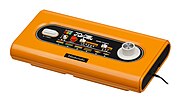
Dr. Mario is a 1990 action puzzle video game produced by Gunpei Yokoi and designed by Takahiro Harada. Nintendo developed and published the game for the Nintendo Entertainment System and Game Boy consoles. The game's soundtrack was composed by Hirokazu Tanaka.

Waluigi is a character in the Mario franchise. He plays the role of Luigi's arch-rival and accompanies Wario in spin-offs from the main Mario series, often for the sake of causing mischief and problems. He was created by Camelot employee Fumihide Aoki and is voiced by Charles Martinet, who described Waluigi as someone who has a lot of self-pity and would "cheat to win."

Wario is a fictional character in Nintendo's Mario series, designed as an arch-rival to Mario. He first appeared in the 1992 Game Boy game Super Mario Land 2: 6 Golden Coins as the main antagonist and final boss. His name is a portmanteau of Mario's name and the Japanese word warui (悪い), meaning "bad". Wario was designed by Hiroji Kiyotake, and is voiced by Charles Martinet, who voices many other characters in the series, such as Mario, Luigi, and Waluigi.

R.O.B. is a toy robot accessory for the Nintendo Entertainment System (NES). It was launched in July 1985 as the Family Computer Robot in Japan, and October 1985 as R.O.B. in North America. Its short lifespan yielded only two games in the Robot Series: Gyromite and Stack-Up.

Ice Climber is a vertical platform video game developed and published by Nintendo for the Nintendo Entertainment System in 1985. In Ice Climber, the characters Popo and Nana, collectively known as the Ice Climbers, venture up 32 ice-covered mountains to recover stolen vegetables from a giant condor. In some European countries, the NES console was sold bundled with the game, increasing Ice Climber's familiarity outside Japan.
A minigame is a short video game often contained within another video game, and sometimes in application software or on a display of any form of hardware. A minigame contains different gameplay elements than the main game, may be optional, and is often smaller or more simplistic than the game in which it is contained. Minigames are sometimes also offered separately for free to promote the main game. Some minigames can also be bonus stages or secret levels.
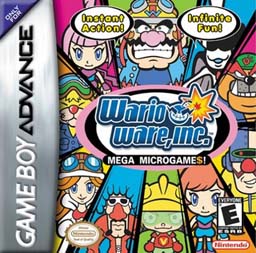
WarioWare, Inc.: Mega Microgames!, stylized as WarioWare, Inc.: Mega Microgame$! and known in the PAL region as WarioWare, Inc.: Minigame Mania, is a minigame compilation party video game for the Game Boy Advance. The debut title in the WarioWare series, the game is about rapid completion of "microgames", short minigames given to the player consecutively and with increasing speed per each game complete. Developed by Nintendo R&D1 and published by Nintendo, the game was inspired by the "Sound Bomber" mode of Mario Artist: Polygon Studio for the Nintendo 64DD. The music and sound effects were recycled from Wario Land 4. The game was produced by Takehiro Izushi and directed by Hirofumi Matsuoka. Matsuoka was also the director of Polygon Studio. Mega Microgames! was released in 2003; in Japan in March, in North America and Europe in May and in Australia in June.

Balloon Fight is an action video game developed by Nintendo. The original arcade version was released for the Nintendo VS. System as Vs. Balloon Fight, and its Nintendo Entertainment System counterpart was internationally released in 1986. The gameplay is similar to the 1982 game Joust from Williams Electronics. The home Nintendo Entertainment System version was ported to the NEC PC-8801 in October 1985, the Sharp X1 in November 1985, the Game Boy Advance as Balloon Fight-e for the e-Reader in the United States on September 16, 2002, and as part of the Famicom Mini Series in Japan on May 21, 2004. It was later released through Nintendo's Virtual Console and is currently available to play on Nintendo Switch Online.

Mach Rider is a futuristic vehicular combat video game created by Nintendo. It was first released in 1985 for the Nintendo Entertainment System. The Family Computer version can use the Famicom Data Recorder to save custom tracks.
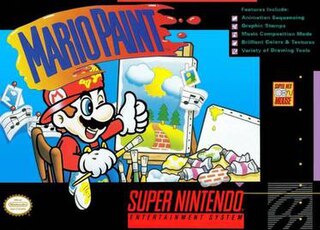
Mario Paint is a video game released in 1992 by Nintendo for use with the Super Nintendo Entertainment System. It is packaged with the Super NES Mouse peripheral. The game was developed by Nintendo Research & Development 1 and Intelligent Systems.

Hogan's Alley is a 1984 video game by Nintendo. It was one of the first games to use a light gun as an input device. The game presents players with "cardboard cut-outs" of gangsters and innocent civilians. The player must shoot the gangs and spare the innocent people.

Wild Gunman is a light gun shooter game created by Nintendo. Originally created as an electro-mechanical arcade game in 1974 by Gunpei Yokoi, it was adapted to a video game format on an arcade cabinet and light gun. It was released in 1985 as a launch game for the Nintendo Entertainment System with the Zapper light gun.
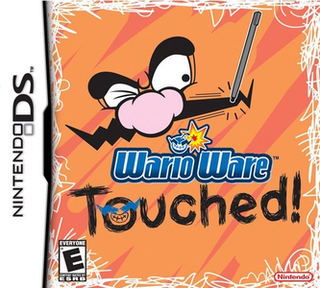
WarioWare: Touched! is a minigame compilation party video game released by Nintendo for the Nintendo DS. The fourth installment of the WarioWare series, and the first of three on the Nintendo DS, the game involves rapidly completing "microgames" — simple minigames lasting extremely short periods of time — as quickly as possible. The microgames are exclusively controlled with the Nintendo DS's touchscreen and microphone.

WarioWare: Twisted! is a party video game for the Game Boy Advance, developed by Nintendo SPD with Intelligent Systems and published by Nintendo. It was released on October 14, 2004 in Japan; May 19, 2005 in Australia; and May 23, 2005 in North America. The third game in the WarioWare series and the seventh in the Wario series overall, Twisted! was the last Wario game to be released on a Game Boy family system.
Game & Watch games have had many different re-releases.

Sheriff, also known as Bandido, is a 1979 arcade game by Nintendo. It is one of a group of Western-themed video games from the 1970s, preceded by at least Western Gun, Outlaw, and Boot Hill. The player controls a county sheriff tasked with defense of a town against bandits, to rescue the captured woman.

Wario is a video game franchise, a spin-off of the Mario series. It comprises various video games created by Nintendo, starring the character Wario. The franchise began with Wario Land: Super Mario Land 3, the first game to feature Wario as a playable character. The Wario series includes mostly platforming video games and minigame compilations, but also includes other genres.
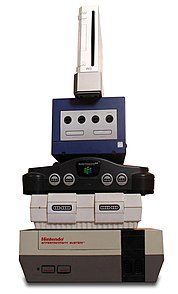
The Japanese multinational consumer electronics company Nintendo has developed seven home video game consoles and multiple portable consoles for use with external media, as well as dedicated consoles and other hardware for their consoles. As of September 30, 2015, Nintendo has sold over 722.22 million hardware units.
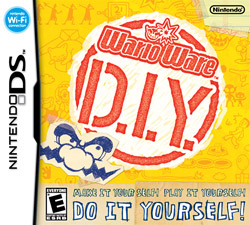
WarioWare: D.I.Y., known as WarioWare: Do It Yourself in the PAL region, is a mini-game compilation and design video game released for the Nintendo DS in 2009. It is the seventh title in the WarioWare series, after WarioWare: Snapped! It was revealed at Nintendo's conference on October 2, 2008 and it was released in Japan on April 29, 2009. It was released in 2010 in North America, Europe and Australia respectively and was accompanied by a separate WiiWare title, WarioWare: D.I.Y. Showcase. The game revolves around the Super MakerMatic 21, a machine that allows players to make microgames, music records and 4-page black-and-white comics.







